Two contrasting galaxies in Coma Berenices
2021 March 28
Compared to the prominent constellations surrounding it, Coma Berenices is certainly not a showpiece object. In fact with the naked eye you are more likely to see the fuzzy collection of faint stars forming the open star cluster within the constellation than the outline of the constellation itself. This cluster, officially labelled both Melotte 111 and Collinder 256, is usually referred to simply as the Coma Cluster. It contains around 40 stars covering some five degrees of sky and lies at a distance of 280 light-years. In small binoculars it appears V-shaped (I always think it looks rather like a tuning fork) and in mythology represents the severed hair of Queen Berenice, who cut off her tresses in gratitude to the gods for the safe return of her husband from battle.
If the constellation lacks bright stars it certainly does not lack interesting deep-sky objects, in particular, galaxies. In spring, when our view is away from the obscuring dust of the Milky Way and is directed out into deep space, we are looking towards the Coma-Virgo galaxy cluster: the heart of the local supercluster of galaxies.
Before we get to the galaxies, however, it is worth pointing out one unsung deep-sky hero that often gets overlooked in Coma: the globular cluster M53 (NGC 5024). It was discovered by Johann Bode in 1775 and independently by Charles Messier in 1777, who regarded it as circular and conspicuous. It lies just one degree north-east of magnitude 4.3 alpha Comae Berenices (RA 13h 11m, Dec. +17° 25′) and at magnitude 7.7 is easily seen in medium-power binoculars. An image of M53 obtained by Martin Mobberley in 2005 May is shown here. Taken through his Celestron C14 and Paramount ME set-up, using an SBIG ST9XE camera, the image time was 2×180s. North is up and the field is 13×13 arcminutes. As Martin pointed out in his accompanying email, the central concentration of this cluster is only 60 light-years in diameter: clearly not the best home for a deep-sky observer!
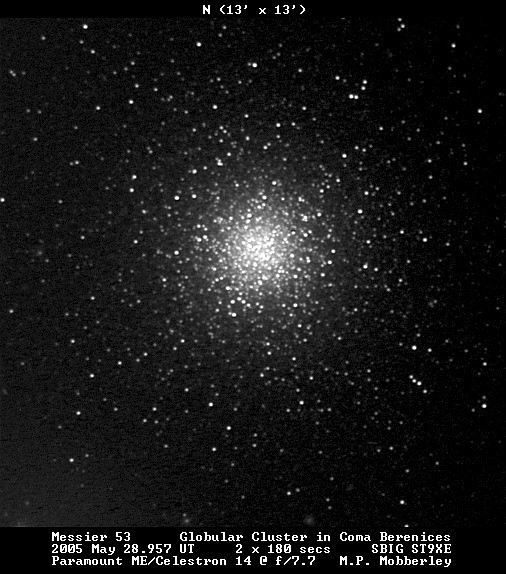
If you observe M53 through a reasonably sized telescope (say, a 20–25cm reflector) at low power, you should also see another globular cluster in the same field of view. This is the magnitude 10 NGC 5053, which lies one degree to the south-east of M53. A William Herschel discovery from 1784, this is a very loose globular (class XI) compared to the more concentrated (class V) M53. Interestingly, deep images show there is evidence of a tidal bridge between the two clusters, suggesting they may have interacted in the past. Both lie at a distance of some 53,000 light-years.
Returning to galaxies, there are 18 Messier examples in the Coma/Virgo Cluster: seven in Coma and 11 in Virgo. It is two of these Coma galaxies that we return to now: M98 (NGC 4192) and M99 (NGC 4254). They lie just over one degree apart, close to the constellation’s southern boundary with Virgo and roughly 6.5 degrees east of Denebola, the tail star of Leo (RA 11h 49m 4s, Dec. +14° 34′). Their respective coordinates are RA 12h 13.8m, Dec. +14° 54′ and RA 12h 18.8m, Dec. +14° 25′. M98 has a visual magnitude of 10.1 and M99 a magnitude of 9.9. They lie at a distance of some 65 million light-years, with M98 blueshifted (moving towards us at around 243km/s) while M99, and the majority of the other galaxies in the cluster, are redshifted (moving away from us). In fact at 2,380km/s, M99 has the largest redshift of any galaxy in the cluster. Both galaxies were discovered by Messier’s observing colleague Pierre Méchain in 1781 and observed by Messier himself later that same year. From central UK in mid-April the galaxies will be found close to the meridian at 23:00 UT at an altitude of around 45 degrees, well away from the low-level light pollution and atmospheric murk that so often spoil observations.
M98 is classified as an SAB galaxy in the Gérard de Vaucouleurs classification system (an updated version of the tuning fork diagram introduced by Edwin Hubble in 1926). This means that the galaxy is an intermediate spiral between barred and unbarred. Although it has a catalogue size of 9.1×2.1 arcminutes, small telescopes are more likely to show a size closer to 6×2 arcminutes. Visually it is an interesting object, appearing almost edge-on. In a small telescope (it is an easy target in my 63mm Zeiss Telementor on a good night) it will show a bright, slightly mottled envelope with a slightly brighter core. Care is needed to keep the magnitude 5 star which lies 30 arcminutes due east of the galaxy out of the field of view, as its light will easily swamp that of the object. Larger telescopes will show similar detail but with less visual effort required from the observer, while they may also show a small stellar nucleus and some hint of spiral structure. The galaxy is elongated NNW–SSE.
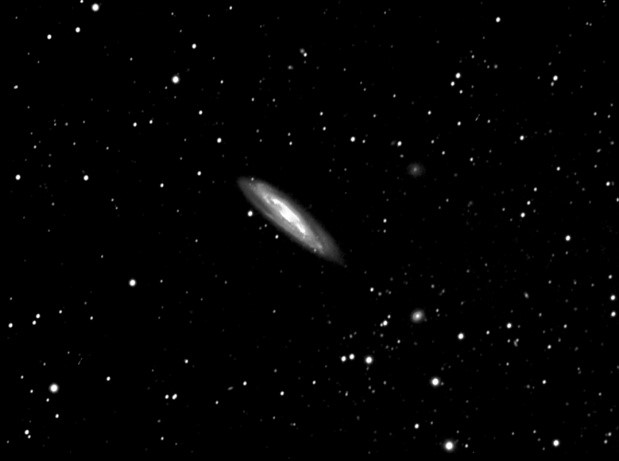
Two images of M98 by BAA members are shown here. Paul Whitmarsh imaged the galaxy in 2008 February using his William Optics 110mm ƒ/6.5 refractor and Starlight Xpress MX916 camera. The exposure time was 50 minutes, in 10min subs. The bright elongated core is clearly shown. Andrea Tasselli also imaged the galaxy in 2008 with his Intes-Micro MX809 ƒ/10 Maksutov and Starlight Xpress SXV-H9 camera, capturing considerable detail within the galaxy.
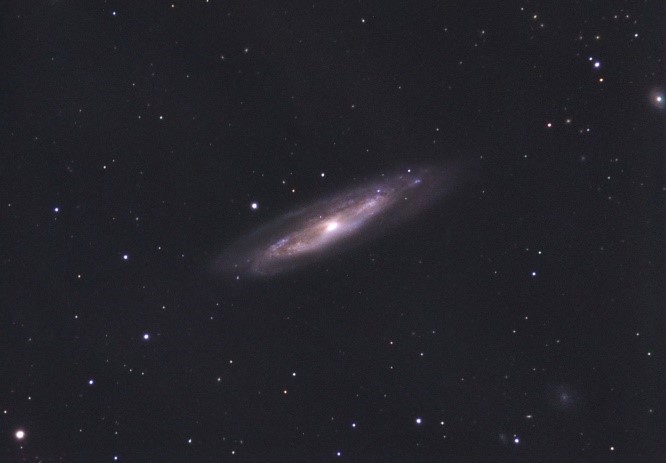
While M98 appears almost edge-on, M99 appears face-on and is often referred to simply as the Coma Pinwheel Galaxy. The two galaxies, which lie just 1.3 degrees apart, provide an interesting and contrasting pair in a low-power eyepiece, although at such low magnification little detail will be seen in either object. M99 is an SA(s)c galaxy: an unbarred spiral with loosely wound spiral arms. Images usually show a lot of detail that escapes the visual observer, unless you have a telescope in the half-metre class along with pristine skies.
M99 was the second ‘nebula’ observed by Lord Rosse to show spiral structure. He observed it in the spring of 1846 with the 6ft reflector at Birr castle, one year after he had discovered the spiral nature of M51. The galaxy has also been home to several recent supernovae with discoveries in 1967, 1972, 1986 and 2014; it is likely that more will be found in the future.
Galaxies are notoriously sensitive to sky conditions and low-surface-brightness, face-on spirals particularly so. Small telescopes – say, 10cm aperture – will show a faint circular halo of around 3arcmin in size with a slightly brighter core, while increasing the diameter to 20–30cm should bring more detail into view. Averted vision, good dark adaptation and observer perseverance will often tease out faint structure, so do not give up if initially you see little detail.
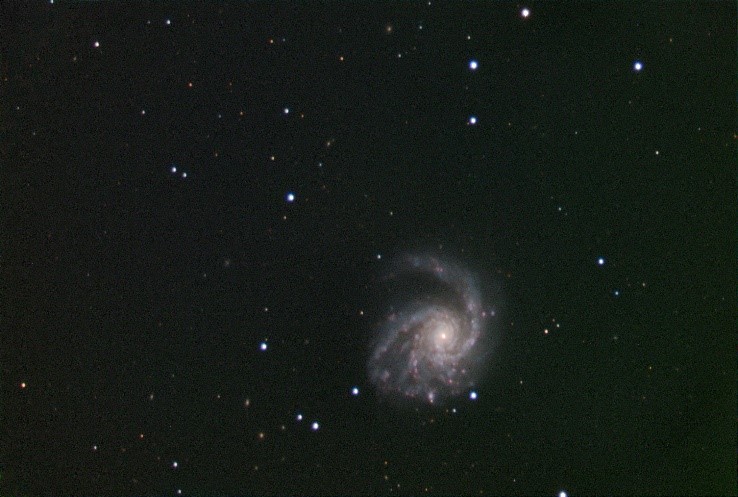
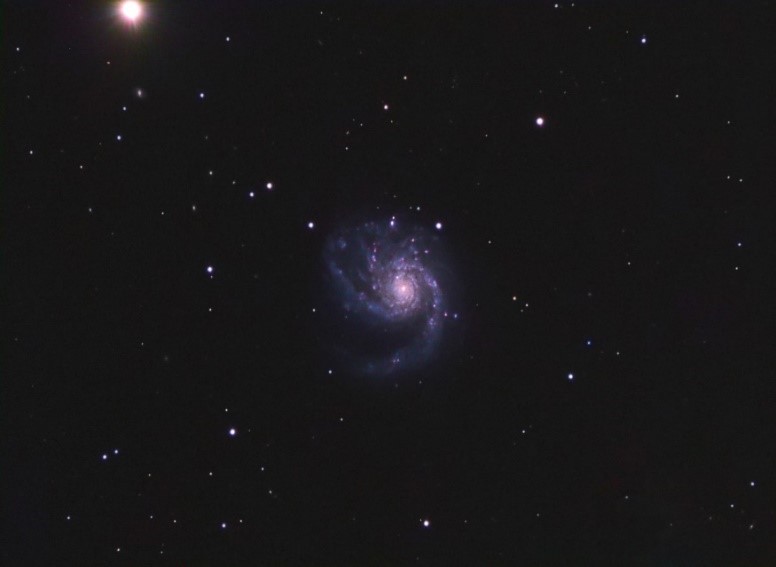
Paul Downing imaged M99 from his observatory in southern Spain in 2012 May, using his 12.5-inch PlaneWave telescope and QSI 863 camera. The exposure time was 50 minutes luminance and 40 minutes each in RGB, in 5min subs. Andrea Tasselli imaged the galaxy from his observatory in Lincoln, UK, using the same equipment set-up as for his image of M98 shown above. The total exposure time for this galaxy was 600 minutes, which included 260 minutes of luminance and 80 minutes in H-alpha. The two major spiral arms are clearly seen in both these images, with one of the arms appearing normal and the other distorted and dragged out. This distortion, along with the offset of the nucleus from the centre of the galaxy and the large amount of new star formation observed, suggests that M99 has probably interacted with other cluster members in the past.
Stewart Moore, Director, Deep Sky Section, 2004-’13
| The British Astronomical Association supports amateur astronomers around the UK and the rest of the world. Find out more about the BAA or join us. |
